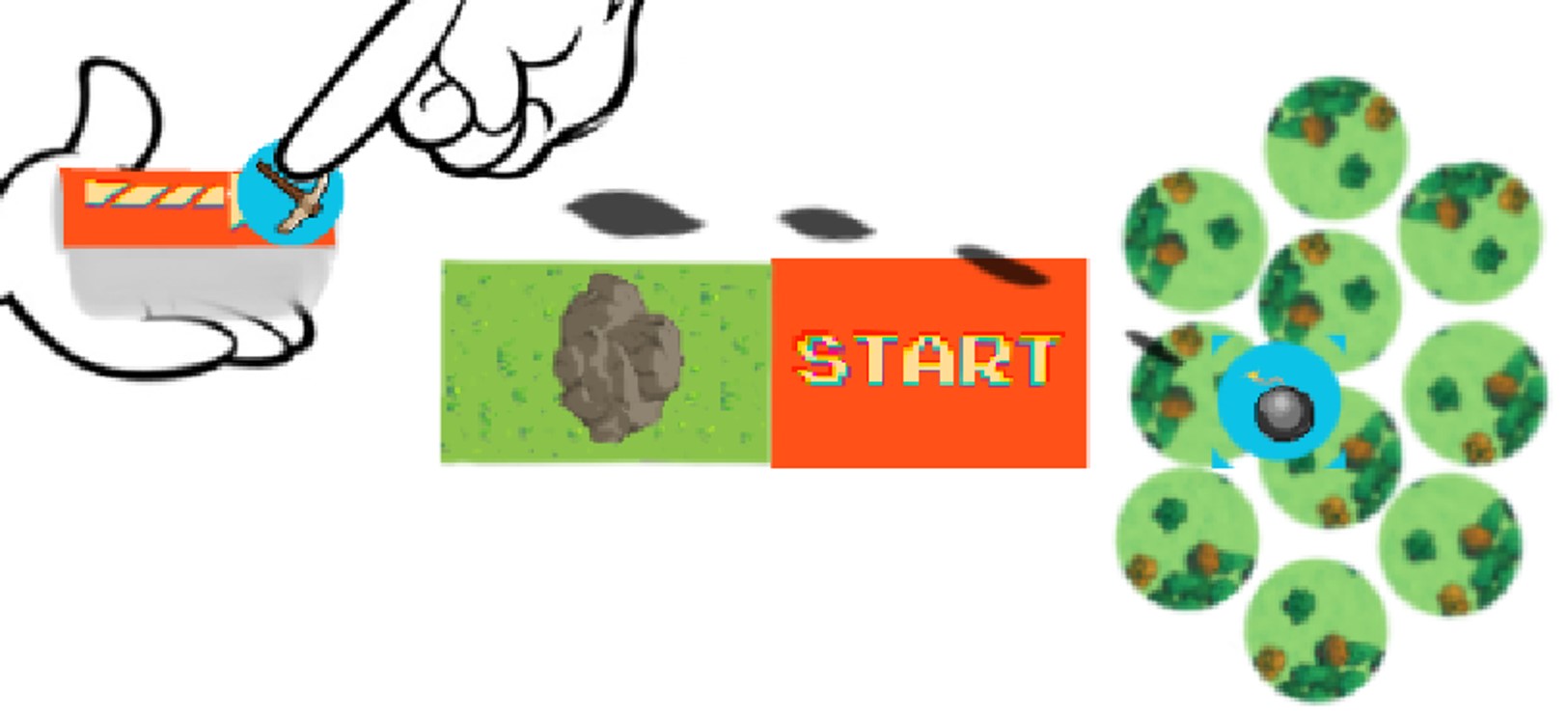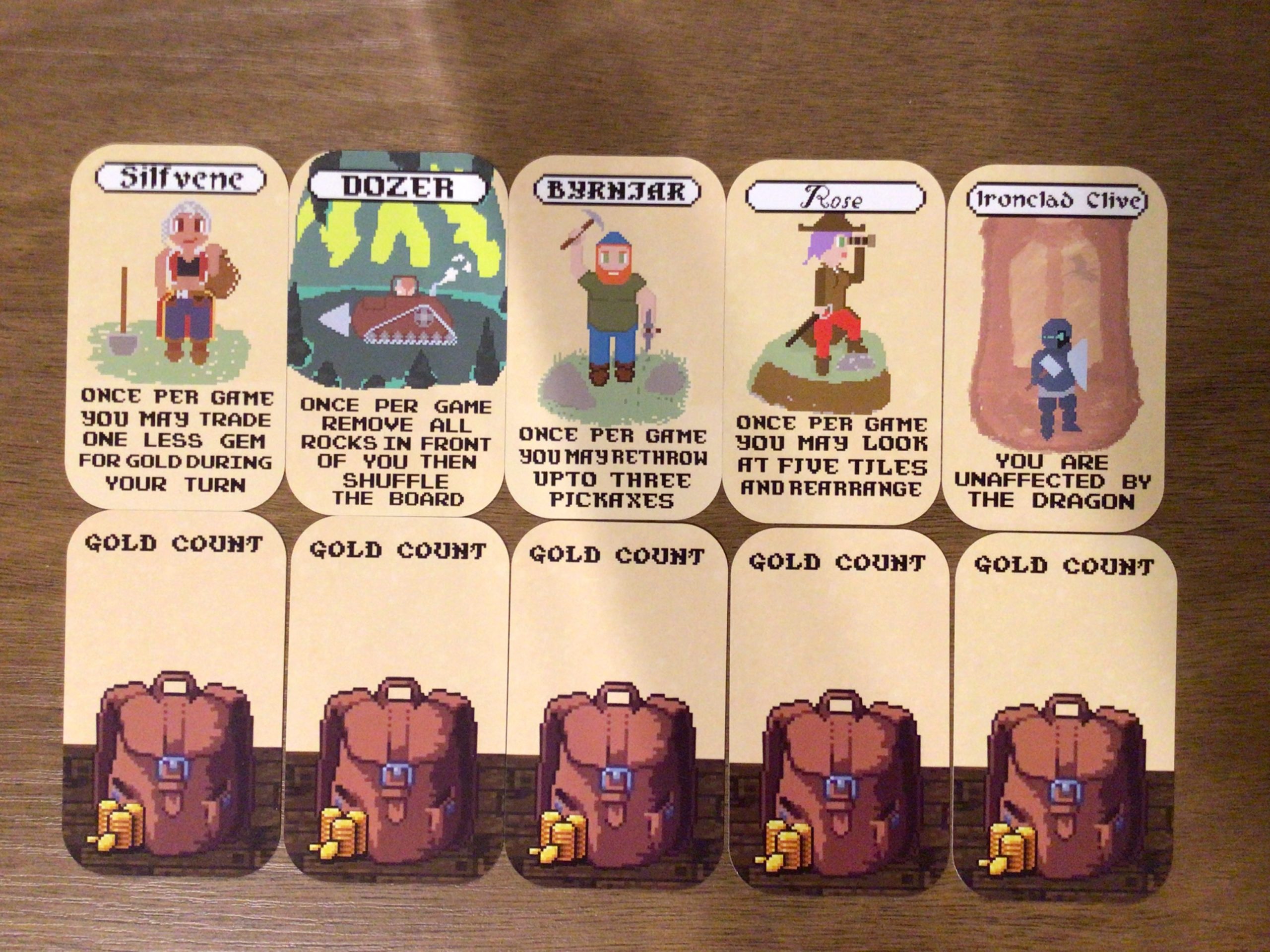You’re on vacation and your kids are not happy having to hunker down in your hotel room because of something something something. Looking back, I remember this situation all too well. “Can You Dig It” (2-5 Players, Ages 12+, Average Play Time = 30 Minutes) comes in a small portable tin case and may be just what you parents need to keep your kids occupied for a short while. Before we begin I’m required by FTC regulations to disclose that I was paid to cover this game, however any and all opinions are my own. This being a preview, rules and components are also subject to change.
Components & Setup
My copy came with “start” cards, a round tracker (card & token), gem pieces, gold pieces, terrain tiles, pickaxe/bomb tokens (double sided), character cards, and stickers to put on the plain tin case. The arrow sticker will be put on the bottom of the tin for reasons explained later.
To set up the game, each player receives a start card, a character, and all pickaxes/bombs of the same color. Then, a player will shuffle the circular terrain tiles face down and arrange them in a loose circular pattern. Gems, gold, the game’s tin case, and the round tracker are put off to the side within easy reach of players.
Gameplay
“Can You Dig It” is primarily a dexterity game where players will be attempting to “throw” their pickaxes/bombs onto the facedown tiles in the hopes of collecting goodies. To throw a pickaxe/bomb, the player will lay their start card longways between them and the facedown tiles as close as possible without touching. Using the back of a tin (utilizing the arrow), players will use their finger to slide their token (either side up) off the tin, over their start card, and hopefully onto a tile. The tin cannot pass the start card, similar to that of the throw line in bowling. Rocks lengthen this space, so players will be trying to get rid of them as soon as possible.
The game itself is played over ten rounds. The round counter will move forward at the end of every round (except round ten, in which case it’s game over). At the beginning of round six, the board of terrain tiles is shuffled and laid back out into a loose circular pattern like in setup. During a round, each player will get to take a turn in clockwise order.
A player’s turn consists of the following:
1. Throw pickaxe/bomb tiles and flip tiles – The token will either land axe-side up or bomb-side up. If an axe lands on multiple tiles, the player chooses which to flip. If a bomb is face up flip over its tile and one other adjacent tile.
2. Gather gems and place rocks – For each gem revealed, the player takes a gem of the matching color from the bank. If a rock is revealed, the pickaxe/bomb token is broken and must be repaired in order to be used again. A separate rock card (stored off to the side) is attached to the player’s start card, closer to the player, creating a longer space between the player and the tiles. If the dragon is revealed, the player gives all gems they have to the bank after finishing their turn.
3. Trade in gems, repair, and/or pass – Players can trade in gems (to the bank) to repair pickaxe/bomb tokens at a 1:1 ratio. Rock cards act the same way at a 1 gem : 1 rock card ratio. In the rare event all of a player’s pickaxe / bomb tokens are broken, the player can trade one gold for any three gems. If the player is completely broke, they get one pickaxe / bomb token back for free in exchange for skipping their next turn.
4. End Turn – Flip all revealed tiles face-down. Play proceeds clockwise.
Whomever has the most gold at the end of ten rounds is the winner. Gems break ties, though players can trade in three gems of the same color for one gold or five gems of any color for one gold.
The above doesn’t cover all of the rules found in the manual, but should give you an idea as to how the game is played. I also must remind you that the above rules are subject to change.
The Preview
“Can You Dig It” falls into that “safe” family-friendly category in that you’ll never have to worry about inappropriate content. It’s also incredibly simple in that you “throw” (more like launching…kinda) tokens onto tiles to hopefully score big. It’s portable nature is a plus, allowing folks to take it almost anywhere, though I wouldn’t recommend trying this at your local restaurant. I imagine that pickaxe/bomb token soup probably doesn’t taste very good.
Dexterity games and I don’t get along mainly due to personal health reasons. Flicking games tend to be chaotic and I end up launching components underneath a couch or into the next room. Dropping games (games where you drop stuff from a certain height onto the table) also tend to be messy. I’m glad to report that even I had no trouble with this particular mechanism in that it wasn’t as physically demanding (but still somewhat challenging).
There’s a memory element to this which I can appreciate even though I don’t like memory games (dementia runs in the family). Tiles are flipped face-down after every player’s turn so it’s important to try and remember where things are so you can get an idea on where to aim. While not listed in the rulebook, you can homebrew the rules so that tiles are kept face-up until a reshuffle occurs. I would actually prefer it to be this way so that everyone playing is on equal footing and not reliant so much on their memory.
While we’re on the subject of home-brewing, players can also create handicaps if one player is clearly dominating with their accurate throws. You can add more start cards to the player you want to penalize so that they have to throw from farther back. You could ignore the bomb side of tokens and just observe both sides as a pickaxe. I’ll let you discover more of those possibilities on your own.
I appreciated the ten different characters and their unique abilities. All can be used once per game, though the one is simply immune to dragons. Most of these abilities break the rules in some way…free repairing, free rock removal, free bomb moving, discount trading, and so on. I think it was a good move to include abilities on these character cards.
This isn’t a review so I’ll simply offer some suggestions and call it a night. For starters, the rulebook was a bit plain/vague in some places and that required me to ask the developer several rules questions. It’s a tin and I know space is tight, but perhaps a more comprehensive downloadable PDF rulebook available on the store page would be a good next step. It should also include a table of contents and further distinction between the dual-sided pickaxe/bomb tokens. The rulebook would often refer to the pickaxes without explaining how bombs were treated, for example.
Editor’s Note: The developer has since reworked / reworded the rules as of 7/12/2023, after the writing of the above paragraph.
One last word of advice…please try to avoid laser cut components if at all possible. The dreaded “soot” fingers came back and it’s incredibly annoying to wash off. Almost every Game Crafter game I have been sent features these and I can’t recommend against them enough. There’s just got to be a better way to not use plastic and still not mark everything up with soot. I was, however, happy with the bag of gems & gold however these don’t seem to fit in the tin. I would have gone for a slightly larger tin, if possible.
You can find “Can You Dig It” on the game’s “Game Crafter” page, linked below. Here’s hoping the developer can gain the momentum they need to further QC the game with better rulebooks and components.
His plans for pricing his Saturday Crowdfunding Sale are, and I quote, “My plan is to start at 30$ move down 2% every 10 sold until 100. so at 100 sold the price would be 24$. At 500 sold the price would be 22$. At 1000 sold 20$.”*
*Editor’s Note 7/17/23 – Crowdfunding date has changed, the date has yet to be determined.
Again, all of that is subject to change. If interested in more of a visual overview feel free to check out the video below.
—
Game Crafter: https://www.thegamecrafter.com/games/can-you-dig-it2
—



